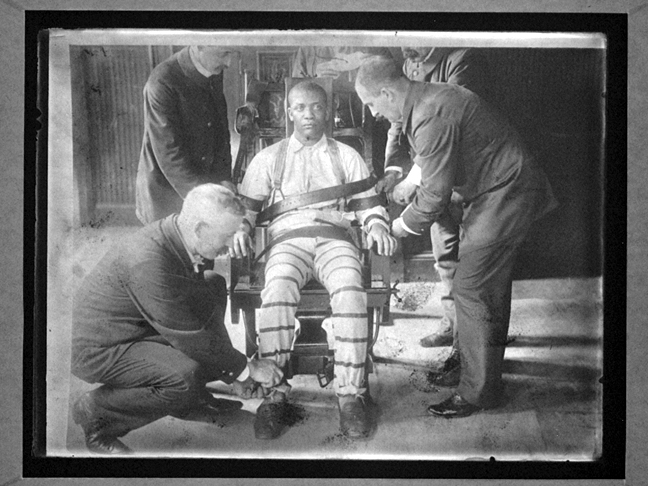As you know, two days ago the State of Arizona staged a botched execution in which the condemned inmate gasped and snorted and made other sounds for almost two hours before eventually dying. Here’s the surreal transcript of the lawyers in the case on the phone with the judge (among other things trying to figure out how to set up a conference call) quasi-litigating what to do as the execution continued on without the prisoner actually dying. The state prison chief’s new claim that, in fact, “parts” of the execution went “perfectly” only underscores what increasingly looks to be the freakish and chaotic end-state of capital punishment in America.
As botched as the Arizona execution was, there is at least a plausible argument – supposedly backed up by an MD in the execution chamber – that Joseph Wood was comatose or brain dead while this was happening and thus, despite the gruesomeness of the description, not experiencing pain. But if we want an example of a truly horrific botched execution where there’s zero question the inmate was in pain, popping in and out of consciousness, struggling, having to tell the executioners, Yes, I’m definitely still conscious! just look to Oklahoma back in April and the execution of Clayton Lockett. There’s really no other way to describe what happened other than simply having you read this timeline of events. It went so badly that the director of prisons eventually decided to stay the execution. About twenty-five minutes later, Lockett in fact died of a massive heart attack.
Why is this craziness happening now?
The simplest, best, and almost certainly accurate explanation is that as the noose has tightened around the death penalty, both internationally and within the United States, fewer and fewer credentialed experts have been willing to involve themselves with state mandated executions. Pharmaceutical companies have become more aggressive in making sure their drugs are not used to kill people. (Here’s a good run-down of the way in which Europe has sequentially banned exports of a series of drugs used in US executions – forcing states with the death penalty to keep switching from one drug to the next to evade the export bans, thus inevitably going further and further into unknown territory in terms of how these drugs work in an execution setting with relatively untrained staff.) Medical experts – or really anyone with serious life sciences expertise – just won’t participate anymore. I’m not saying never. But it’s become much more difficult. And in order to access and use the relevant medications without the knowledge of pharmaceutical companies, the people charged with finding ways to carry out executions now mostly have to operate in secret. Secrecy leads to a lack of transparency and review of methods which in turn produces more badly conceived plans and botched executions.

Hanging of the Lincoln assassination conspirators. Mary E. Surratt, Lewis Payne, David E. Herold, George A. Atzerodt. July 7th, 1865.
It’s not hard to kill someone. It’s not even very difficult to kill someone painlessly. That is, as long as you know what you’re doing. But under current circumstances it’s not much of an exaggeration to say you’re having people with little to no clinical experience – often with high school biology level of life sciences knowledge, like most of us have – devising methods to kill people. On top of that, the people actually preparing the chemicals and carrying out the execution aren’t experienced clinicians either. Which is another reason for mistakes. So sequences of drugs that may be ill-conceived from a clinical perspective, administered by people who aren’t doctors, lack clinical experience and don’t execute people that often – all a recipe for mistakes and mishaps.
It seems reasonable to assume that if you had a team of doctors, including anesthesiologists, who planned and administered a sequence of drugs to cause a pain-free death, they would probably be able to pull it off pretty successfully. But of course doctors, for a lot of obvious reasons, won’t do that. And they are increasingly resistant to involving themselves even tangentially.
Obviously this kind of clinical experience isn’t particularly relevant if you’re executing someone by firing squad. And there was no pretense that electrocution or execution in the gas chamber was an easy exit. Actually, hanging, properly done, is a fast death. But as my colleague David Kurtz put it in a conversation yesterday, the whole idea that you can somehow reverse engineer the medical profession with prison and corrections officials is a bit of a sick joke.
Now Alex Kozinski, a brainy rightwing appellate court judge, has attracted attention by arguing that we should simply go back to execution by firing squad, that it would be a better, more consistent and even more humane form of execution than the current methods of lethal injection. There’s a mixture of wisdom and trollish provocation in this argument. But there’s no doubt he’s right. Execution by firing squad really would be more humane than what happens in some lethal injection executions.
There’s a subtext here, which is that the effort to make executions look more humane, in some respects to make them actually more humane, has had the paradoxical effect of making them more uncertain and barbaric.
I’m not sure whether Kozinski’s statement amounts to a sign of changing opinion or a rueful admission of defeat. I’m also not sure if it matters.
But none of this bizarre confluence of events makes sense without stepping back and seeing the broader context: fewer and fewer people support the death penalty. That is the case at the level of elite opinion with medical professionals and in the Courts. But more importantly it’s happening at the popular level as well.
As I noted above, one of the drivers of recent events is activism in Europe which is choking off the supply of drugs used for executions and, paradoxically, leading to an increasing number of ghastly botched executions – which is in turn souring more people on the practice in general.
About a decade and a half ago, I wrote a piece – to some controversy – in The New Republic which argued that the reason the death penalty had been outlawed in Europe while it flourished in the United States had much less to do with public opinion than it did with the structure of European governments. I was able to show pretty conclusively that in every case in which there was any clear public opinion data available, European governments outlawed the death penalty despite the fact that their populations still supported it. American states, more responsive to public opinion or populist/demagogic politics – depending on your perspective – kept it going and even revived it because people wanted it.
My argument about the ‘why’ had to do with how parliamentary democracies are more immune to single issue populist politics than the American system. But the ‘what’ was not really disputable: public opinion data showed that Europeans supported capital punishment almost as much or as much as Americans. That reality just didn’t seem to matter at the level of policy.
But since I wrote that piece that’s changed a lot, as you can see in this chart of Gallup polls on the death penalty going back to the 1930s.

The why is also clear as day. Correlation does not prove causation. But from the rise in the mid-60s to the decline in the late 90s, it is quite clear that support for the death penalty rose and fell with the perception and reality of rising rates of violent crime, especially murder, the ultimate violent crime. Note in both charts above and below the rise beginning in the mid-1960s and the decline beginning in the mid-late 1990s. The chronological correlation is very, very tight.

Gallup still shows that capital punishment has clear majority support – about 60%. But it’s lower than it’s been in forty years. And it’s falling. What’s more, there’s little reason to believe that decline will be arrested unless the longterm trend of declining violent crime rates suddenly changes. (A sidenote: Did lead poisoning, of all things, cause the spike in violent crime in the second half of the 20th century? The case is considerably stronger than you might think.)
Kozinski says we shouldn’t try to pretty up the death penalty. “Executions”, he writes, “are, in fact, brutal, savage events, and nothing the state tries to do can mask that reality. Nor should we. If we as a society want to carry out executions, we should be willing to face the fact that the state is committing a horrendous brutality on our behalf.” I’m not sure Kozinski has any problem with that. And many people are quite comfortable with it or claim that they are.
But the reality is that most are not. We can see that in the declining support for capital punishment noted above and the fact itself of the grand experiment in peaceful, purportedly suffering-free execution we’ve been discussing. If people were comfortable with firing squads we’d still have them. But we don’t.
I don’t pretend that the death penalty will be outlawed any time soon. I don’t have specific numbers in front of me; but I specific the aggregate national numbers mask major regional differences. So absent dramatic action from the Supreme Court, which seems quite unlikely, it will likely continue – perhaps for quite some time – in major death penalty state like Texas, Oklahoma and others. (37% of executions in the United States since the resumption of capital punishment in 1976 have taken place in Texas.) But the trajectory and increasing confinement of capital punishment seems clear: Diminished popular support, a growing number of states with de facto abolition in addition to the 18 states with de jure abolition, and an increasing difficulty with carrying out executions, both in terms of the actual mechanics of death as well as advancing them through the courts. The corridor forward seems narrower and narrower, with tightened restrictions generating more difficulties and a negative feedback loop based on grisly botched executions and the perceived incompetence of the executing authorities. The time till the end is not clear but the progression and nature of the end seems more and more evident.







